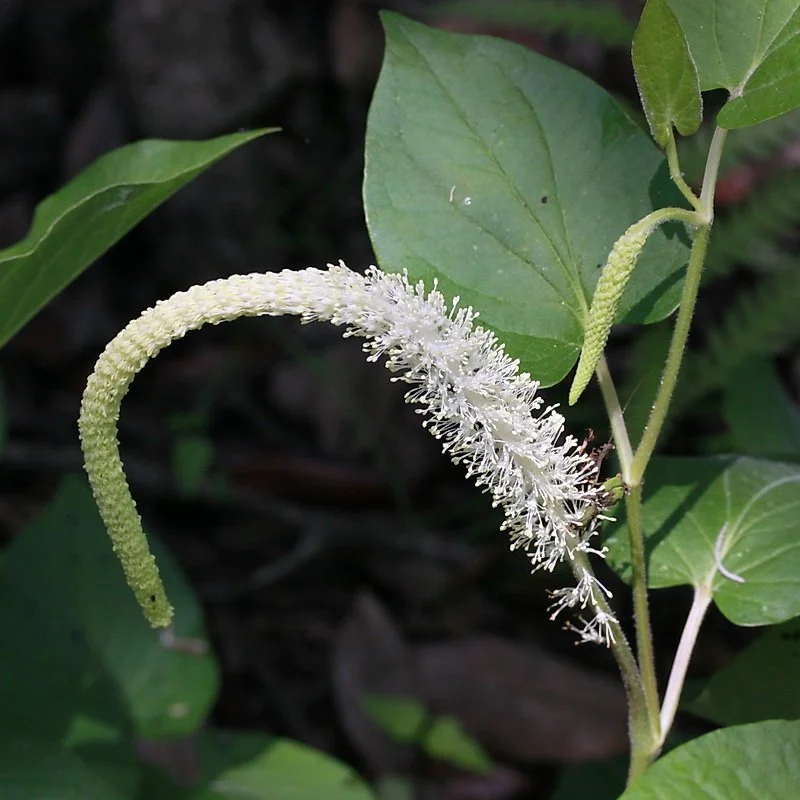When it comes to bodies of water, whether a river, ditch, or rainwater runoff pond, people are often intimidated with how to landscape. But I believe the true beauty of Florida is what lies in the water. There is an overwhelming amount of native plants that are the happiest with wet feet, ranging from stunning wildflowers, sturdy shrubs, to great canopy trees.
Lizard Tail, Saururus cernuus, is an extremely common native wetland perennial, found throughout the eastern United States. It thrives in saturated soils, and loves to live in even up to a foot of water. Atop heart shaped leaves, Lizard Tail has a unique bloom in late spring and early summer. As the name suggests, its flower resembles a floppy lizard’s tail. It is creamy white in color, and stands out well against an overall green landscape. I tend to always see tiny bees, wasps, and flies enjoying the sweet flowers. Lizard Tail has a vigorous spreading habit, making huge swaths in roadside ditches, lakesides, river and creek banks, and even in lowlying hardwood forests. It is extremely tolerant of deep shade, and one of my favorite places I had the joy of visiting this past summer was Congaree National Park in South Carolina, which is an old growth bottomland hardwood forest, where Lizard tail, White Swamp milkweed, various sedges, and River Cane are in their prime.
Pickerelweed, Pontederia cordata, is probably our most recognizable native wetland perennial. It has a distinct violet spike for a bloom in late spring and early summer, standing tall amongst glossy, lance shaped leaves. Like Lizard tail, its favorite places to live are river edges, lakesides, and roadside ditches. It can even form dense floating mats, clinging on to fallen trees and debris in the middle of the river. Pickerelweed prefers the sun, but does tolerate some light shade. It is a spreading wildflower, sending rhizomes through the muck creating colonies, and dispersing seeds via water fowl. A great place to see Pickerelweed is along Lake Piney Z, the Wacissa River, or pretty much any body of water here in the Tallahassee region. Be wary not to confuse this native wildflower with the invasive species, Water Hyacinth, Eichhornia crassipes. Water Hyacinth also has a purple bloom, but is much shorter and stockier, and floats on the water's surface due to its buoyant leaves, clogging our natural areas from proper water flow and suffocating our native wetland species.
Duck Potato, Sagittarius lancifolia, is another native wetland perennial that we have all seen before. It has the signature flower that all species of Sagittaria have – a small and delicate white flower with three petals and a yellow or green center. On Duck potato, these flowers are in a cluster on a long stalk standing tall above its spade-like leaves. Unlike Pickerelweed and Lizard Tail, Duck Potato is not shade tolerant and prefers a ton of sun. It can grow in various water depths, ranging from a few inches to a foot. With its clumping growth habit rather than a running one, Duck Potato can look quite stately and robust along the waters edge. My favorite place to see Duck Potato is driving down Highway 98. If you happen to visit Gainesville, the University of Florida’s Natural Area Teaching Laboratory (NATL) has a beautiful pond with a boardwalk, looming Cypress trees, willows, Buttonbush, and of course huge stands of Duck Potato paired with Blue Flag iris.
Do not fear your drainage ditch or unruly puddle. The possibilities are endless when it comes to native wetland loving plants. That unsightly wet area in your yard could be the next neighborhood haven for wildlife.
